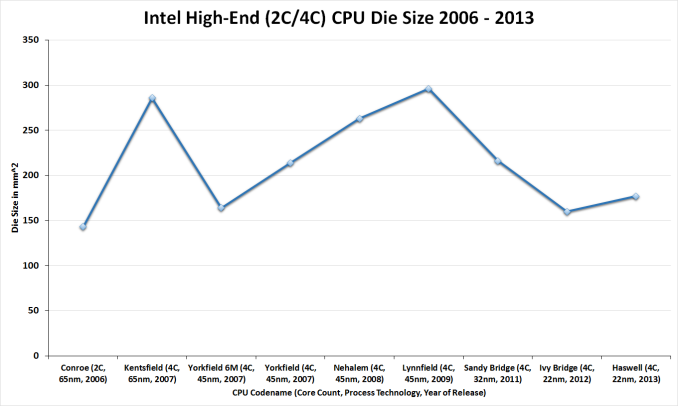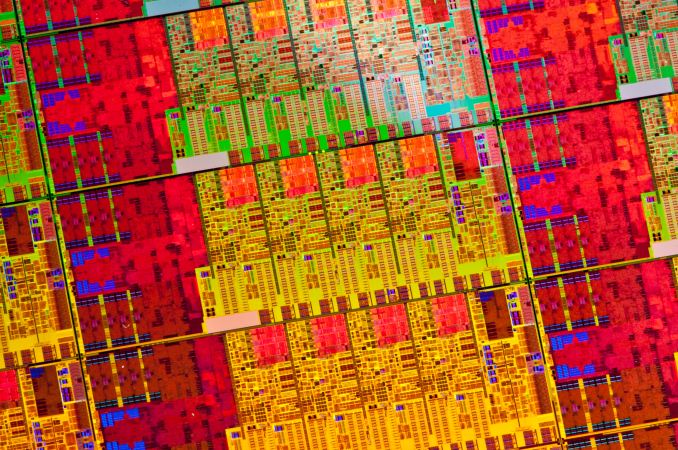The Haswell Review: Intel Core i7-4770K & i5-4670K Tested
by Anand Lal Shimpi on June 1, 2013 10:00 AM ESTDie Size and Transistor Count
Moving on to die sizes and transistor counts, this year Intel is striving to be more straightforward and accurate than was the case with Sandy Bridge and Ivy Bridge. With the Bridge generation we didn’t initially get comparable numbers, only for the correction to throw in additional confusion. For Haswell Intel is laying things out from the start, listing both possible numbers so that either can be compared.
| CPU Specification Comparison | |||||||||
| CPU | Manufacturing Process | Cores | GPU | Transistor Count (Schematic) | Die Size | ||||
| Haswell GT3 4C | 22nm | 4 | GT3 | ? | 264mm2 (est) | ||||
| Haswell GT2 4C | 22nm | 4 | GT2 | 1.4B | 177mm2 | ||||
| Haswell ULT GT3 2C | 22nm | 2 | GT3 | 1.3B | 181mm2 | ||||
| Intel Ivy Bridge 4C | 22nm | 4 | GT2 | 1.2B | 160mm2 | ||||
| Intel Sandy Bridge E 6C | 32nm | 6 | N/A | 2.27B | 435mm2 | ||||
| Intel Sandy Bridge 4C | 32nm | 4 | GT2 | 995M | 216mm2 | ||||
| Intel Lynnfield 4C | 45nm | 4 | N/A | 774M | 296mm2 | ||||
| AMD Trinity 4C | 32nm | 4 | 7660D | 1.303B | 246mm2 | ||||
| AMD Vishera 8C | 32nm | 8 | N/A | 1.2B | 315mm2 | ||||
The two numbers for the most common Haswell configuration, Haswell GT2 4C, are 1.4 billion schematic transistors and 1.6 billion layout transistors. Why and what is the difference? The former count is the number of transistors in the schematic (hence the name), and is generally the number we go by when quoting transistor counts. Meanwhile the second number, the layout number, is the number of transistors used in the fabrication process itself. The difference comes from the fact that while the schematic will use one large transistor – being a logical diagram – production will actually use multiple transistors laid out in parallel for layout and process reasons. So how many transistors does Haswell have? It has both 1.4B and 1.6B, depending on which number we’re after, with 1.4B being the number Intel is passing around.
In any case, even among quad cores Haswell is going to come in a couple of different sizes. Along with the 1.4B transistor, 177mm2 4C/GT2 version of Haswell, there is the 4C/GT3 version of Haswell, which Intel doesn’t list the die size or transistor count for. Based on our rough measurements of the physical die we’re at 264mm2, which including the epoxy covering the die will run a bit large.
Breaking things down to the GPU portion of Haswell, based in turn on these measurements I came up with an 87mm^2 adder for the extra hardware in Haswell GT3 vs. GT2. Doubling that 87mm^2 we get a rough idea of how big the full 40 EU Haswell GPU might be: 174mm^2. If my math is right, this means that in a quad-core Haswell GT3 die, around 65% of the die area is GPU. This is contrary to the ~33% in a quad-core Haswell GT2. I suspect a dual-core + GT3 design is at least half GPU. Meanwhile Crystalwell, the 128MB eDRAM, adds another 84mm2 die (by our measurements) to the entire package.
On a comparative basis, the 4C/GT2 version of Haswell is roughly 200M transistors and 17mm2 bigger than the comparable 4C/GT2 version of Ivy Bridge. The transistor count increase is roughly what we’d expect, with most of those transistors going to Haswell itself while the GPU remains relatively unchanged. Though it’s interesting to note that while this marks a 17% increase in transistors, it’s only an 11% increase in die size. Ivy Bridge was a small die for an Intel, and while Haswell grows larger in exchange for the additional functionality the new architecture provides, it’s still a fairly small GPU and reaches a density greater than Ivy Bridge itself. Or to put this another way, Intel’s last tock CPU, Sandy Bridge, was larger still by almost 40mm2. It’s only once we start adding the relatively big GT3 GPU, and not the CPU, that we see Intel go well above 200mm2.












210 Comments
View All Comments
klmccaughey - Monday, June 3, 2013 - link
AMD are a damn sight closer on Nvidia than they are to Intel, though still sandbagging for this year. It's a bad year for us upgraders!aCuria - Saturday, June 1, 2013 - link
This review needs a compilation speed test against the 3930k, I would really like to know if haswell could edge out the 3930k in that testKevin G - Saturday, June 1, 2013 - link
Haswell met expectations in terms of IPC increases and power reductions. Both of those are good things overall. However, I feel disappointed and that comes down to how Intel has segregated their product line up: GT3e and TSX are only available on select parts. Ideally on the high end I'd like to get a socketed chip with an unlocked multiplier, GT3e, TSX, and Hyperthreading. Of those five criteria, at best I can get three of those. I suspect that this is due to Intel keeping several possible configurations reserved for their Xeon lineup but those chips won't have an unlocked multiplier.I'm currently an owner of a Sandybridge i7-2600K and the current performance of the Haswell parts aren't that tempting to jump the configurations Intel is selling. So I'm left waiting another year for a future desktop refresh before making the jump. Oh wait, Broadwell is going to be strictly a mobile refresh (and possibly a desktop BGA) refresh. So the best upgrade path for me for the next couple of years is to wait for a cheap i7-3770K on clearance. Otherwise the price/performance gains are radically higher as to not be worth it (also would need to get a new motherboard for socket 1150). I guess I'm left waiting for Skylake, get lucky that Intel adds several SKU's that I want or see what AMD can produce for the desktop.
Khato - Saturday, June 1, 2013 - link
Just curious as to your source for TSX only being available on select parts? The only place I saw that was on the Tom's Hardware preview. It's not in any of the reviews that I've seen?amock - Saturday, June 1, 2013 - link
According to http://ark.intel.com/products/75123/Intel-Core-i7-... the 4770k doesn't have TSX support.Kevin G - Saturday, June 1, 2013 - link
Intel is likely keeping TSX away from any desktop part with eDRAM. I suspect that having a massive L4 cache and TSX may make these quadcore chips very competitive with some of their socket 2011 parts based upon Sandy bridge/Ivy Bridge cores. These would happen in heavily memory bound applications like some database operations tend to be. Intel hasn't updated ARK with all of the Haswell chips yet so I'm be curious to see if their will be a mobile part with GT3e + TSX. I'd love it if some enterprise DB's supporting TSX were tested on this platform to see if this idea pans out.smilingcrow - Saturday, June 1, 2013 - link
The i5/i7 K series socketed desktop chips don't have eDRAM anyway so that's a moot point; they both lack TSX support.Kevin G - Monday, June 3, 2013 - link
Well it does look like that the L4 cache in GT3e parts can make Haswell competitive with socket 2011 six core chips. Check out the i7 4950hq results from Tech Report's Euler 3D fluid dynamics tests:http://techreport.com/review/24879/intel-core-i7-4...
The i7 4950 was likely seeing a strong benefit from an open air test bed (it is a mobile part) so I suspect that it can reach its 3.4 Ghz four core turbo relatively often. I still would expect slightly better performance if the 2.4 Ghz base clock was raised. The i7 4950 is further handicapped as the L3 cache was cut down to 6 MB and was using SO-DIMM memory with loose timings. The kicker is that this is with legacy code with any AVX2, FMA or TSX benefits.
I really, really want an unlocked, noncripppled socket 1150 part with GT3e.
just4U - Sunday, June 2, 2013 - link
Well.. your already on a i7.. and tbh I'd say the 2600K is better than the 3770K. .I purchased a 2700K even though the 3770K was out. Why? Well.. lower heat and miniscule gains in the 3X line.. plus when I decide to OC I'll likely get more out of my chip (as will you..) than they get on the IvyBridge processors.Kevin G - Monday, June 3, 2013 - link
I currently have my i7 2600K running at a conservative 4.2 Ghz. I've gotten it to boot at 4.6 Ghz with ease and probably could go further if felt like increasing voltages and got better cooling (though it is in a 4U server case so cooling options are a bit more limited).Price drops are happening for the i7 3770K. Probably need to wait a bit more and might pick one up if they drop further. Microcenter has dropped them to $230 already.